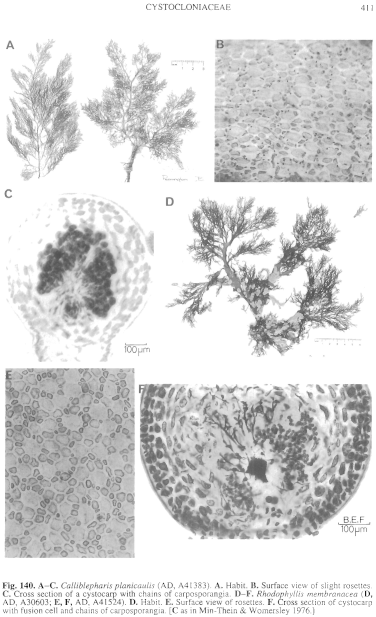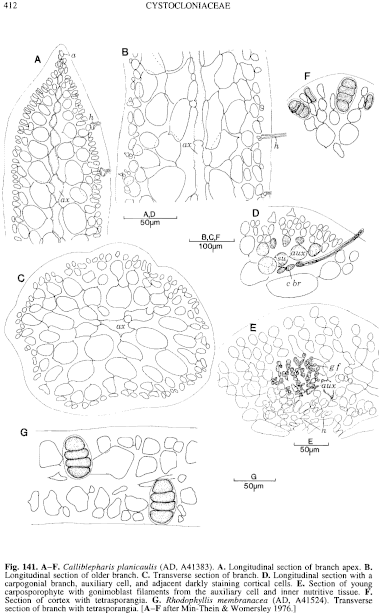|
|
|
|
|
|||||||||||
|
Electronic Flora of South Australia Species Fact Sheet
Phylum Rhodophyta – Class Florideophyceae – Order Gigartinales – Family Cystocloniaceae
Selected citations: May 1965: 407. Min-Thein & Womersley 1976: 129, figs 47, 68.
Synonyms
Hypnea planicaulis Harvey 1859b: 315.
Rhodophyllis (?) hypneoides Harvey 1862: pl. 199. J. Agardh 1876: 368. De Toni 1897: 348. Lucas 1929a: 17.
Thallus (Fig. 140A) medium red to red-brown, 10–30 cm high, much branched irregularly for 3–4 orders, lesser branches radial but from the margins of the slightly compressed main branches together with branchlets from their faces; lower branches 2–5 mm broad, 0.5–1 mm thick, ultimate branchlets terete, not or slightly basally constricted, 100–200 µm in diameter, with acute apices; hairs often numerous; some branches with terminal hooked, thicker, tendrils. Holdfast fibrous; epiphytic. Structure (Fig. 141A, B) uniaxial, with a projecting apical cell and each axial cell with two periaxial cells; axial filament conspicuous (Fig. 141B, C) in older branches, without rhizoidal filaments but with secondary pit-connections to inner cortical cells. Cortex 4–6 cells broad, inner cells ovoid and 20–40 µm in diameter, becoming 100–150 µm in diameter, surface rosettes (Fig. 140B) usually present but weakly developed, cells 5–10 µm across. Rhodoplasts ovoid to elongate, becoming ribbon shaped and branched.
Reproduction: Sexual plants dioecious; procarpic. Carpogonial branches (Fig. 141D) 3-celled, borne on mid cortical cells, orientated sideways with a reflexed trichogyne. Auxiliary cell (Fig. 141D) next outwards from the supporting cell, becoming darkly staining as do adjacent cortical cells, with outer cortical cells dividing to form the pericarp and cells inward to the auxiliary cell cutting off small darkly staining nutritive cells. Following fertilization and fusion with the auxiliary cell, a gonimoblast initial (Fig. 141E) is cut off laterally and divides to form gonimoblast filaments, some connecting with the nutritive tissue and others developing thallus outwardly to form branched, terminal chains of ovoid carposporangia 20–28 µm in diameter, together with some sterile filaments connecting to pericarp cells. Cystocarps (Fig. 140C) on lesser branches, subspherical, protuberant and becoming basally constricted, 300–600 µm in diameter, with a pericarp 3–4 cells thick, nonostiolate. Spermatangia covering the surface of branchlets, cut off via initials from outer cortical cells, ovoid, 1.5–2.5 µm in diameter.
Tetrasporangia (Fig. 141F) scattered in the cortex of young branches, often aggregated into son part way along the branch and often on one side, pit-connected laterally to subsurface cells, ovoid, 20–35 µm in diameter, zonately divided.
Type from Georgetown, Tas.; lectotype in TCD (Alg. Aust. Exsicc. 342).
Selected specimens: Safety Bay, W. Aust., drift (Womersley, 29.ix.1979; AD, A50748). Elliston, S. Aust., 11 m deep in bay (Shepherd, 27.x.1971; AD, A42678). Point Avoid, S. Aust., drift (Womersley, 2.xii.1975; AD, A46902). Tiparra Reef, S. Aust., 11 m deep on Amphibolis antarctica (Shepherd, 5.xi.1971; AD, A38314). Port Elliot, S. Aust., drift (Womersley, 17.x.1948; AD, A9375). Pennington Bay, Kangaroo I., S. Aust., drift on Amphibolis (Kraft & Min-Theirs, 3.xii.1971; AD, A41383). Cape Jaffa, S. Aust., drift (Womersley, 10.xii.1991; AD, A61577). Garden Beach, Portland, Vic., drift (Beauglehole, 11.viii.1951; AD, A21691). San Remo, Vic., drift on outer beach (Sinkora A2223, 19.x.1975; AD, A48504). Walkerville, Vic., drift (Sinkora A1630, 23.ii.1972; AD, A43127). Low Head, Tas., drift on Amphibolis (Perrin, 8.x.1950; AD, A16430). Musselroe Bay, Tas., drift (Perrin, 11.i.1947; AD, A8491). Eddystone Point, Tas. (Perrin 481, 9.ii.1948; BM).
Distribution: Safety Bay, W. Aust., to Walkerville, Vic., and the N coast of Tasmania.
Taxonomic notes: Calliblepharis planicaulis is probably normally epiphytic on Amphibolis (both species) and larger algae, and most drift specimens have been torn off the host. It resembles Hypnea ramentacea Hooker & Harvey in having tendrils, but the latter has terete branches throughout, lacks rosettes, and the carposporangia are borne singly.
References:
AGARDH, J.G. (1876). Species Genera et Ordines Algarum. Vol. 3, Part 1 - Epicrisis systematis Floridearum, pp. i-vii, 1–724. (Weigel: Leipzig.)
DE TONI, G.B. (1897). Sylloge Algarum omnium hucusque Cognitarum. Vol. 4. Florideae. Sect. 1, pp. 1–388. (Padua.)
HARVEY, W.H. (1859b). Algae. In Hooker, J.D., The Botany of the Antarctic Voyage. Flora Tasmaniae. Vol. II, pp. 282–320.
HARVEY, W.H. (1862). Phycologia Australica. Vol. 4, Plates 181–240. (Reeve: London.)
KYLIN, H. (1932). Die Florideenordnung Gigartinales. Lunds Univ. Årsskr. N.F. Avd. 2, 28 (8), 1–88, Plates 1–28.
LUCAS, A.H.S. (1929a). The marine algae of Tasmania. Pap. Proc. R. Soc. Tasm. 1928, 6–27.
MAY, V. (1965). A census and key to the species of Rhodophyceae (red algae) recorded from Australia. Contr. N.S.W. natn. Herb. 3, 349–429.
MIN-THEIN, U. & WOMERSLEY, H.B.S. (1976). Studies on southern Australian taxa of Solieriaceae, Rhabdoniaceae and Rhodophyllidaceae (Rhodophyta). Aust. J. Bot. 24, 1–166.
The Marine Benthic Flora of Southern Australia Part IIIA complete list of references.
Publication:
Womersley, H.B.S. (14 January, 1994)
The Marine Benthic Flora of Southern Australia
Rhodophyta. Part IIIA, Bangiophyceae and Florideophyceae (to Gigartinales)
Reproduced with permission from The Marine Benthic Flora of Southern Australia Part IIIA 1994, by H.B.S. Womersley. Australian Biological Resources Study, Canberra. Copyright Commonwealth of Australia.
Illustrations in Womersley Part IIIA, 1994: FIGS 140 A–C, 141 A–F.

Figure 140 enlarge
Fig. 140. A–C. Calliblepharis planicaulis (AD, A41383). A. Habit. B. Surface view of slight rosettes. C. Cross section of a cystocarp with chains of carposporangia. D–F. Rhodophyllis membranacea (D, AD, A30603; E, F, AD, A41524). D. Habit. E. Surface view of rosettes. F. Cross section of cystocarp with fusion cell and chains of carposporangia. [C as in MM-Thein & Womersley 1976.]

Figure 141 enlarge
Fig. 141. A–F. Calliblepharis planicaulis (AD, A41383). A. Longitudinal section of branch apex. B. Longitudinal section of older branch. C. Transverse section of branch. D. Longitudinal section with a carpogonial branch, auxiliary cell, and adjacent darkly staining cortical cells. E. Section of young carposporophyte with gonimoblast filaments from the auxiliary cell and inner nutritive tissue. F. Section of cortex with tetrasporangia. G. Rhodophyllis membranacea (AD, A41524). Transverse section of branch with tetrasporangia. [A–F after MM-Thein & Womersley 1976.]

|
Email Contact: State Herbarium of South Australia |

|